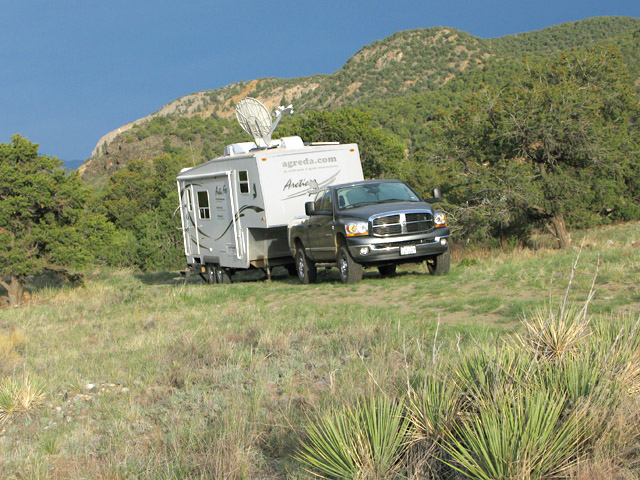 Nearly two years of keeping up this RV travel blog and it dawns on me that we’ve really only written this one boondocking tip, for conserving water.
Nearly two years of keeping up this RV travel blog and it dawns on me that we’ve really only written this one boondocking tip, for conserving water.
Well, considering we have now gone as many as 45 days without hookups – not too recently, mind you – it seems appropriate to provide some tips for making the most of your boondocking days.
First, we refer to boondocking here as anytime we’re not hooked into the grid for the night. Ergo, any night spent without hookups is boondocking to us – whether it be out in the boonies or in a WalMart parking lot. Technically though, according to a “Disconnected RVing” article in the Escapees magazine we now get; if your staying in a campground without hookups, that is considered Dry Camping.
But this post isn’t about linguistics. It’s about seeing how long you can go without hookups, comfortably. And comfort is the key here. It takes a certain level of which to truly enjoy long term boondocking. Which we do, so keep that in mind as we share our methods, or madness depending on how you look at it …
Go Solar – A basic system including solar panel, charge controller and inverter will help keep your batteries charged and provide AC power when not plugged in. As with anything of course, the more you spend the more you get. A large bank of 6v batteries and multiple solar panels may enable you to go longer before re-charging, if you have to at all. But this can quickly drain the pocketbook. We get by with one 120w solar panel, a 2400w inverter and the two 12v RV batteries that came with our trailer.
Stay Charged Up – To keep your batteries healthy, never let them drain completely. Many recommend charging batteries if they fall below 12 volts. Our inverter will automatically shut off if voltage drops below 11.7 volts. Get yourself an accurate voltmeter and run your generator to charge batteries as often as necessary.
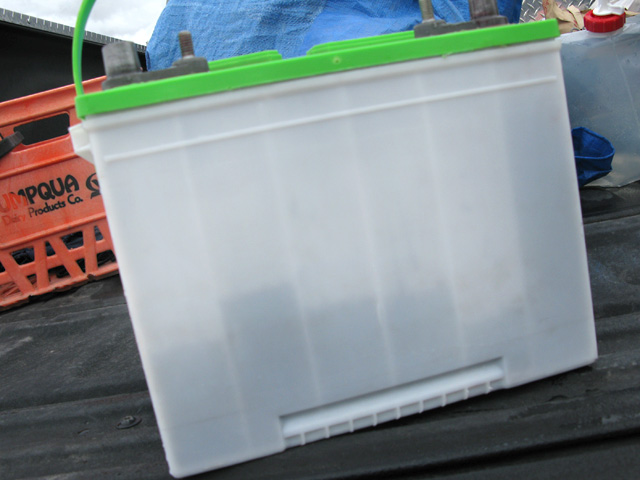 Maintain those Batteriers – Be sure to check your batteries regularly. We learned the hard way. If they are not the sealed maintenance free type, keep distilled water on hand and top them off as necessary. Boondocking often means bumpy roads, so ensure all battery connections are tight, and no wires may be causing shorts in the system.
Maintain those Batteriers – Be sure to check your batteries regularly. We learned the hard way. If they are not the sealed maintenance free type, keep distilled water on hand and top them off as necessary. Boondocking often means bumpy roads, so ensure all battery connections are tight, and no wires may be causing shorts in the system.
Use the Sun – Solar power is best suited for “float” charging which is basically keeping batteries topped off when they are about 90% charged. So take breaks during the day to let the sun do its work. A generator is better suited for “absorbtion” when battery power is further depleted. The best time to fully charge batteries with your generator is in the morning when they are at rest.
Consider Your Position – You know your rig. If you have solar panels, park so they get maximum exposure to the sun throughout the day. For us, it is best to park facing the northwest. That way our satellite dish will not cast a shadow on our solar panel.
Go in the Woods – Use vault toilets whenever available, or a tree if not, to conserve water from flushing.
Bundle up – In cold weather, put on a sweater or grab another blanket before considering wasting battery power and propane by running the furnace.
Strip Down – If it’s hot, put on your shorts or consider moving on to where it’s not. Your air conditioner will quickly drain your batteries, if your solar power system is capable of running it.
Stock Up – Before heading out to the Boonies, always ensure your fresh water tanks are full and you have plenty of gas for your generator and propane in your tanks. It helps to have empty waste water tanks too!
Stock Up Some More – Carry extra fresh water with you when planning extended stays without hookups. We use three collapsible 5 gallon water jugs and various other containers for topping off our tank.
Conserve – Sounds simple, but it is the most important thing to consider when boondocking. And it relates to both power and water. Use headlamps or battery powered lanterns rather than your house lights. Never leave lights on when not needed. We go so far as to remove the LP leak detector fuse so its LED light doesn’t glow.
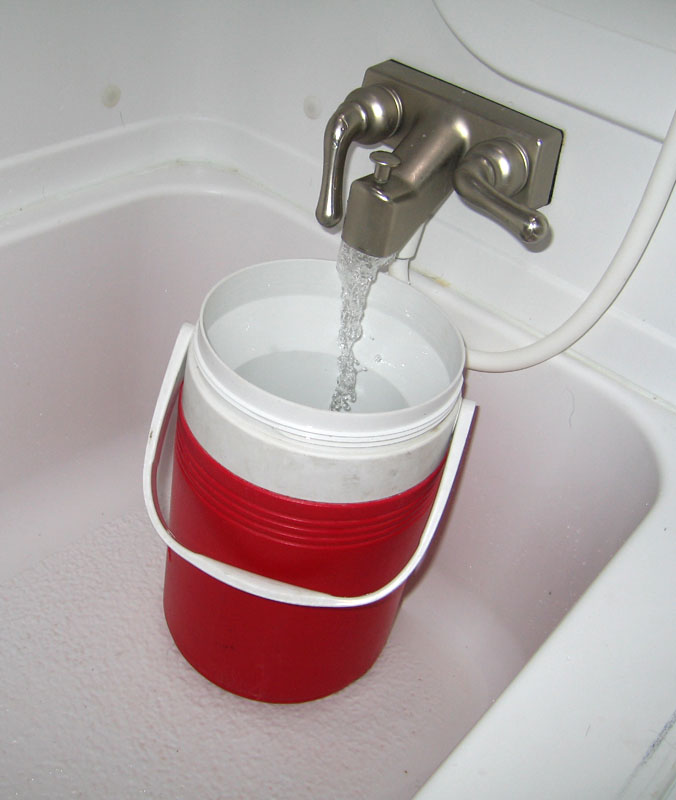 Conserve More – Never let the water run when doing dishes. Clean pots and utensils using a bowl of soapy water then rinse all at once under dripping water. Using paper plates and disposable cups will eliminate the water needed to wash them. And remember, cast iron pans don’t need scrubbing and can usually just be wiped clean.
Conserve More – Never let the water run when doing dishes. Clean pots and utensils using a bowl of soapy water then rinse all at once under dripping water. Using paper plates and disposable cups will eliminate the water needed to wash them. And remember, cast iron pans don’t need scrubbing and can usually just be wiped clean.
Conserve Even More – When taking a shower, run the water into a tea kettle or other container while it heats up so none is wasted. Take short bird baths with as little water as possible, or consider skipping daily showers. Use body wipes to stay feeling fresh.
Play The Shower Game – Try to see how little water you can actually use. Wet down within a few seconds. Soap up, then rinse off quickly. Shower immediately after one another so you don’t have to wait for the water from the faucet to warm up again.
Fill Your Black Tank – Grey water tanks often fill up quicker than your black water. So wash dishes using a tub and pour the dishwater down the toilet. Turn the water pump off when doing this so the toilet will not flush.
Make One Pot Meals – Plan meals you can make using one pan to reduce dish washing. We find that grilling uses the least amount of dishes and is much more enjoyable anyway.
Wipe Before Cleaning – Wipe out all dirty pans and dishes with a paper towel before washing to reduce the amount of water required.
Work Offline – Our biggest electrical draw is our network. With two laptops, a wireless router, MotoSat dish controller, HughesNet modem and network storage, we can drain our batteries within a few hours on a busy cloudy day. So, we do whatever work we can offline before booting up the network. Leaving the network drive unplugged helps, and once we are locked onto our satellite we also turn off the dish controller since there is no need for that again until we have to put the dish down.
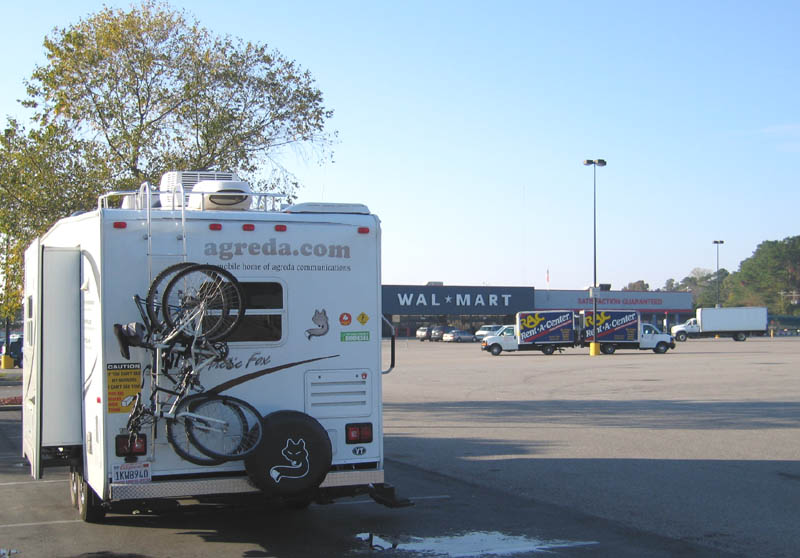 Enjoy it – Boondocking is meant to be fun. It’s the best way to get out and away from it all. When your tanks are empty and full, and you need to recharge yourself, head for hookups to give the rig a good cleaning and enjoy the luxury of lights at night. Then dump and fill up so you can go do it again!
Enjoy it – Boondocking is meant to be fun. It’s the best way to get out and away from it all. When your tanks are empty and full, and you need to recharge yourself, head for hookups to give the rig a good cleaning and enjoy the luxury of lights at night. Then dump and fill up so you can go do it again!
If you have any helpful off-grid RVing, “dry-camping” or boondocking tips of your own please share them by leaving a comment. And let us know how long you have gone without hookups or if you just abhor the idea.
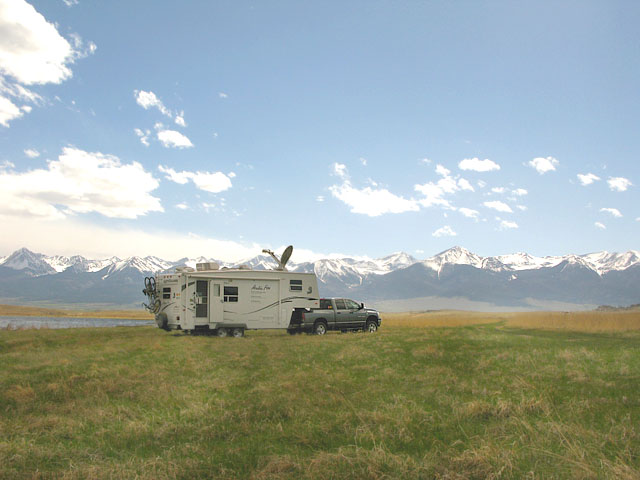
Love the tips AND the comments!!!!
Glad to hear it Sherry! We would love to hear your boondocking advice too so chime in when you can!
Peter and I just have a Westy that we took for 10 days on the Oregon/NoCal coast this summer.
Along the coast, it’s a no brainer to boondock along a river or creek to conserved onboard water. We let the dogs do the “prewash” on the dishes, then use an eco-friendly soap to wash dishes in the river. Clothes and selves are also washed in the river. 2 5-gallon water jugs filled from the river using the fabulous PUR Hiker filter. It’s a really lightweight and easy-to-use filter for backpacking, but I take it on most trips because it not only has a silt filter (large particles) and 0.4 micron filter (every microbe except viruses), but it also has a charcoal filter for taste. I filled my CamelBack from a muddy stream in Belize (not while boondocking!), and got 2 liters of clear, pure, tasty water. I took it on a cruise with my family and used it every day to filter the stale water that came out of the faucet in my cabin. I *love* my PUR filter.
Hair: Hat or bandana. I’ve found that after 5 days, your hair really just *can’t* get much dirtier (this discovery made on a 12 day canoe trip in MN), so tie it back and hide it under a hat or bandana. Need to look/smell better than that? I’ve gotten block braids/corn rows put in. You still wash your hair, but it takes very little water. Not up for the hippie braided look? Cut it *short*. It’s just hair and will grow back ; ).
I have been rving a lot over the last few years and some of me and my wifes little adventures can take on some length thanks for great tips. I find that the biggest thing that has improved our boondocking lives out there is a larger solar panel, we have outfitted our rv roof with all the panels we can afford and can store enough power to get by now. We both work in online marketing so we love being free to go anywhere and work anywhere love the site. Conserving electricity is a biggie so we have outfitted our rv with low consumption technology so a laptop instead of a large tower. we use a satellite for internet and it is ok little pricey though, we had a verizon air card which used cellular services and as long as we didnt get too far out in the boonies we were ok but what can we say we really like to get away from things so the satellite won in the end.
Thanks
Emory in idaho
Thanks for the great comment!
Hm….I could go for that beer part 🙂
HELLO TRAVLERS I NEED YOUR HELP,WE WANT T GO TO GEORGIA AND FLORIDA TO THE BEACHES, I AM A SEA GLASS HUNTER AND NEED TO KNOW WHERE TO STAY, BOONDOCKING IN THESE AREAS AS ALL THE PARKS WILL BE FULL THE SECOND WEEK IN NOV. SO WE DECIDED TO DO SOME BOONDOCKING BUT DON’T KNOW IF WE CAN STAY ON THE BEACH OR AT THE CURB ALNITE WE HAVE NEVER DONE THIS BEFORE . ALL THE PARKS I CALLED IN FLORIDA WILLL BE FULL THE 2 ND. WEEK IN NOV.I WOULD LOVE TO HEAR YOUR IDEALS AND TIPS HAPPY TRAVELING AND BE SAFE MARY SCOTT
We found boondocking on the East Coast to be far and few between. Check the BLM website and rv.net. Good luck and have fun!
PS: WHY ARE YOU SHOUTING!?!? 😉
we keep a clean cooler stocked with ice only. it holds 4 bags of ice or so we use the ice for cold dranks and the water for cooking and washing up ist cold but on a hot day it fells so good. no water used from the camper at all
Great tip! Thanks for sharing.
These are fantastic tips on off grid living. Chris and I have gone up to 7 months boondocking in a row in our solar powered rig (and that was before we had a generator) – it’s fantastic, and really puts you in touch with yourself and the earth. There’s something very empowering about realizing just how self sufficient we humans can be!
One tip for hair washing that saves a bunch of water is going shampoo-free .. I just posted about this:
http://www.technomadia.com/2009/07/two-years-shampoo-free/
We’ve become pros at water conversation as well – we only have a 32.5 gallon fresh water tank, that we can make last for about 2 weeks with careful use.
– Cherie
Wow Cherie, that nopoo thing is really brave. I’m not sure I can do it, but next time we’re hardcore boondocking again I just might. My hair uses SO much water to rinse out, seems like it’s worth a shot. Thanks, I missed that post of yours.
And I agree; knowing that we can be self-sufficient on so little water is just a great feeling. I”m really ashamed of myself when we are using full hookups, like now, and I get back into the habit of using too much water.
The thing about the nopoo is that if you do just while you’re boondocking, you’ll probably hate it. It takes a 2-4 weeks for your hair to transition to it, and those first couple of weeks are pretty nasty feeling. So, just keep that in mind when/if you start it up 🙂
I will, thanks for the clarification!
I’m curious to know what others do for drinking water….
I really really dislike buying bottled water….but…. filters on taps?
installtion of such ? @louise & Sean etc…..
Kelly
@Kelly:
Since we built our bus from the ground up, we were able to install a whole separate 40 gallon drinking water tank. We have drinking water spigots at the kitchen and bathroom sinks. We fill this tank when we find really good water and it lasts months. That’s probably not much help for you, though…
We use a Brita charcoal filter pitcher and just fill it up from our tap.
Oh, this is a fun topic!
The most important boondocking step is where you park initially. In hot weather, park your rig so that your awning is on the south side. That way you can shade as much surface as possible for most of the day. Or, in winter, park so that more windows face south to catch what little sun warmth you can get. Think about how the sun moves during the day to take advantage of shade from trees, buildings, even other rigs.
Park so that the prevailing breezes blow through the rig to cool it down. You *do* have a FanTastic Fan, don’t you? Pull that cool air in!
In winter, put the shortest, least-window covered wall (usually the back, but not always) into the wind.
Hilltops have the best views, and the most wind. Maybe not a good choice in cold weather. If it is really windy and sunny, you may not be able to leave your awning out. Consider a less windy location in that case.
Last week, we took our lawn chairs into a shallow stream and soaked our feet in the cool water. Ah, way better than air conditioning! A glass of wine helped, too.
Invest in insulating window coverings. This could be thick curtains, pleated fabric blinds, or mylar “bubble wrap” pieces cut to size to fit your windows. Bonus: mylar covers keep the light out of he bedroom. Key if you’re late risers like us. Walmart parking lot lights can be brutal, too.
Keep your fridge and freezer full so that there’s less room for warm air to move in when you open the door. Consider no-cook meals, such as big salads.
Make/buy ice and cool each drink with a few cubes, rather than load your fridge up with warm liquids. Or, buy bagged ice and fill a cooler. Melted cooler water can be used to flush toilet.
Combine all your electrical needs to the same time of day, and only run your generator then. For instance, run the genny in the hottest part of the day if you must have a/c, and use that time to cook, run the vacuum cleaner, go on-line, watch a movie, etc. The genny likes to be loaded.
Cat owners: Cranky, cold kitties make excellent bed warmers. Even if they are usually not physically affectionate, they will see you as a big thermal mass. Dogs can be convinced to do anything. Wagging tails create a cool breeze.
Invest in a few “lap throw” sized blankets and wrap yourself up in cold weather. Fleece is great. They take up less space to store, and can be combined to cover the bed. We have a couple that we only use outside around the campfire, so if they get smoky-smelling, that’s okay. Other clean ones are ready for inside snuggling. In summer, they can be used as beach/picnic blankets.
Knee-high socks can make the difference between cold/cranky, and comfy/cozy. Funky scarves and fleece beanie hats are good, too. Ladies, use this as an excuse to buy cute stuff. Socks, scarves and hats are cheap and small and come in a zillion colors and patterns. Add pins and fake flowers! Go wild! Gentlemen of a certain age: the hair on your head has betrayed you. Get a hat, wear it indoors. Cover your extremities!
Wear your hair short. It takes less water to wash and is cooler in hot weather. You give up some winter warmth, but you have 30 cute hats now, so who cares?
I’ll second the suggestion to not shower every day. We switched to every other day and I find my skin is less dry. In really hot weather, we’ll shower more often if needed. Hint: if the dog is gagging as you walk by, it’s time to shower.
Share a flush, save some water: If it’s yellow, let it mellow. If it’s brown, flush it down. True RVing friends will not ask to use your potty for fear of finding the Mellow Yellow.
Louise, those tips are awesome, thank you so much!
I know of one guy who made a setup where he diverted his gray water into his toilet, for flushing. I’d like to try that some day, it makes so much sense.
Rene’s boondocking tips:
– Ladies, when washing your hair while boondocking, use a leave-in conditioner so you don’t have to rinse your hair twice.
– Cook foods that don’t require a lot of water. Pasta is out when we’re conserving water.
– Drink lots of cold beer to conserve fresh water for other uses.